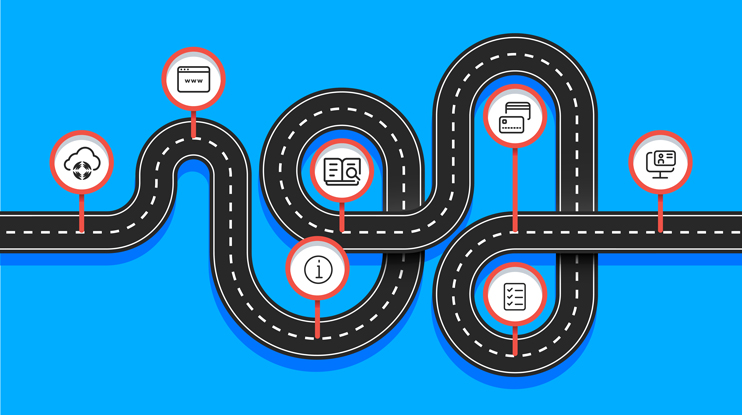Developing relationships based on trust has always been foundational in the financial services industry. But how do you develop trust in a digital environment?
Traditional banks have often relied on in-person interactions to help truly understand what a customer needs. These days, however, more customers are interacting with their financial institution via phone or desktop than in a physical branch. Trouba*, one of the largest wealth providers in the U.S., was one such financial institution. Rapid organic growth, expanding product lines, and multiple knowledge bases led to fractured information that left customers and customer service representatives asking questions instead of finding answers.
Which obviously doesn’t make for a great customer experience. And, according to the CX Relevance Report for Financial Services 2023, 74% of consumers will call it quits with a brand after just two bad experiences. When retail banking and credit unions are increasingly synonymous with digital banking, there are ample opportunities for banks to drop the ball.
So how did Trouba* turn their customer experience around? By heavily investing in customer journey mapping and artificial intelligence.
To better understand how the two go together, first, let’s unpack the fundamentals of customer journey mapping.
What Is Retail Banking Customer Journey Mapping?
Here’s what we think the customer journey map should be, and then there’s what your banking customer actually wants to experience.
We deduce the latter from what customers are actually telling us — data points from websites, customer communities, mobile apps — all the myriad ways that customers interact with us digitally.
This data tells us exactly where, how, and when customers engage with us along the digital banking experience. That’s customer journey mapping in a nutshell: a representation of all the customer insights you’ve collected, from first hearing about you to the post-purchase experience.
As one might imagine, retail banking customer journey mapping can be quite comprehensive. There are different business segments, customer categories, and products.
To capture all of the interactions, including intent, motivation, and sentiment, requires organizational and technological investments.
How To Improve Customer Journey in Banking?
At a high level, here are the traditional best practices that go into building a customer journey map:
1. Define Your Customer Needs
Naturally, the needs you define for your financial services institution will vary from others. All audiences are unique, especially in an age where trust in traditional banks is at an all-time low. This is why it’s so critical that your financial institution digs into the quantitative and qualitative data it has at hand.
Salesforce found that while 51% of financial services leaders say they excel in providing a personalized experience, only 11% of customers agree that their bank anticipates their financial needs. Trouba* experienced this firsthand when fractured knowledge living in different Sharepoint sites led to inconsistent answers for clients.
The thing is, you don’t have to guess about what your customers want. More often than not, they’re already telling you — through content discovery. How customers interact with your digital presence through search, clicks, time on page, and other metrics can tell you a lot about what they’re finding — and where they’re coming up empty.
When you leverage a unified index that uses AI to surface knowledge consistently throughout the digital banking experience, customers feel seen and recognized.
2. Map The Typical Customer Experience Journey
These days, the customer journey map is rarely linear. What we do know is that 50% of consumers interact with their bank weekly through mobile apps and websites. Are those customers, potential or existing, finding the answers they’re looking for?
“We needed to see the world through our clients’ eyes… they view us as one company, not many siloed products,” a knowledge leader at Trouba* said.
Your customers don’t see you as a collection of products and services. They see your company as a single entity, whether they’re on your website from a desktop computer or interacting with a customer service portal on their phone. The experience should be the same, regardless of channel.
By tracking those interactions over time, you gain a better understanding of how a certain customer segment interacts with a customer touchpoint. Are consistent answers being found? If not, then a content source might have been overlooked, or content might be missing entirely.
When you leverage AI, you also ease the ability to manage numerous channels. AI takes on the heavy burden of finding and delivering content, leaving humans to focus on higher-value tasks.
3. Identify The Typical Obstacles Encountered in Each Journey
For example, you can track the common page paths of a specific demographic to figure out why they leave your website without converting on a particular banking product page.
Or perhaps a certain segment calls in with the same objection time and time again, highlighting a lack of information somewhere along the line.
How Banks Can Apply Journey Mapping to Customer Service Initiatives
There’s no question that banks are managing a rapid proliferation of digital channels in banking services. And no matter which channel they choose, customers now demand personalized experiences, almost across the board.
As to what that personalization ought to look like depends on the data. For example, if a bank knows the exact words that a potential customer or existing customer uses to search their site for low-interest home loans, they can personalize search results to bring more value to that experience.
The same goes for queries, questions, clicks, and other interactions. Even from first-party data points alone, banks can extract considerable detail about the customer behavior performed and paths taken by different individuals (or groups), as well as what they might need to take the next step.
Retail Banking Use Case: Behavioral Data
Elsewhere, we’ve defined behavioral data as what customers do and interact with within your digital presence. Let’s consider behavioral data within the context of a specific banking segment: mortgage applicants.
Across the life of a mortgage application, applicants will interact with a variety of digital touchpoints. They fill out the application online, or using the mobile app.
Perhaps they interact with the bank’s educational resources (blog posts, for example) related to mortgages, topics like interest rates, private mortgage insurance, etc. Some will seek more context on payment terms, credit score implications, and so on while they wait for their answer.
All of these data points paint a picture of the mortgage applicant’s journey. One that gives the bank an idea of how to personalize and optimize each banking customer experience for better outcomes.
Of course, capturing and analyzing this kind of data at scale, across customer segments, can be complicated. Indeed, 95% of executives believe that legacy systems and outdated tech capabilities are inhibiting their ability to optimize data.
That said, the right technology is available.
3 Ways AI Enhances Customer Journey Mapping in Banking
So, where should these executives direct their investments? How do retail banks and other financial institutions continuously map and optimize customer journey analytics across their often vast customer bases?
Not surprisingly, AI holds at least some of the answers. AI, and more specifically, relevance platforms, can bring journey mapping to life for retail banks in a few ways:
1. Personalize Search Results Across Digital Channels
Earlier, I touched on the ability to personalize content paths based on behavioral signals. AI can do the same for search, recommendations, and personalization. Relevance technologies use past search term data, clickstream interactions, site behavior, and other data points to boost the most relevant and useful content. For Trouba*, creating a centralized unified index of content led to them achieving a 5% reduction in transfer rate — meaning CSRs knew what customers had already found, and were able to progress to resolution.
What’s more, AI considers what the customer interacts with to learn and improve the next interaction. Here, the potential use cases are many. For example, let’s say over time AI learns that most customers searching for “existing auto loan” aren’t in fact looking to log into their account and check balances. In fact, nine times out of ten, they abandon the journey when they reach the login page from search results.
But when AI boosts the landing page for refinancing a current auto loan, click-through and average click rank go way up. And because search results are now optimized for true user intent, the customer is more likely to actually convert (in this case, apply for a refinance), which can have a direct and measurable influence on revenue.
2. Unearth the Content Customers Want But Can’t Find
An AI search platform can also reveal content gaps. That is, the high-volume search keywords that lead to no results, or very poor click-through rates. The application here is quite simple: a high-volume keyword with “No results returned” indicates a hole in your customer journey.
Imagine if everyone who calls into the contact center frustrated that they can’t apply for a business credit card online would have avoided the call altogether if they could have found the content.
Through content gap analysis, you can find those holes and create relevant content for those search experiences and prevent abandoned or unsuccessful digital journeys.
3. Free Up Talented Support Staff to Focus on High-Level Orchestration
There are some banks, who shall remain nameless, who hire teams of people just to create and enforce business rules. This is a time-consuming effort that can be handed over to AI. While AI automatically learns and optimizes as searches and clicks happen, banking teams can free up headcount to focus time and resources on higher-level customer experience strategy.
For example, Trouba* leadership estimated six months for time to value in implementing Coveo. They were surprised to see results in eight weeks because of service-trained ML that recognized customer behavior patterns in key interactions. This helped them achieve a nearly 12% reduction in average handling time, allowing agents to focus on higher-value conversations with customers.
It’s flipping the script really; rather than use headcount to guide customers toward a particular outcome, you put that energy toward creating new and improved outcomes. In the context of service, some call this a shift-left model: customer queries are handled by the lowest-effort, least expensive support tier.
Ideally, that lowest tier is actually self-service, which is continuously run and optimized with the help of AI.
The Last Word on Journey Maps for Banking
We have so much to learn from our customers, and customer journey mapping can help. It’s an exercise in understanding who our customers are, what motivates them, and what they need — in their own words and based on their behavior.
Why do it? To keep customers happy and retain them long-term, yes. More specifically, we’re answering the call of the day, which is elevated customer expectations. Being there even when customers don’t expect us to be. Today, customers don’t just demand it, but they’ll switch banks in a heartbeat if they can’t get it.
To deliver on this caliber of experience, 63% of retail and institutional banks plan to invest in customer data analytics; and 60% plan to invest in customer service. Unfortunately, 84% face challenges adopting AI in support of these efforts. As our own customers in banking and finance are discovering, a relevance engine bridges the gap between planned investments and persistent challenges to improving the customer experience.
Of which AI-enhanced customer journey mapping plays a central role.
Learn more about Trouba*’s success with Coveo:
*Pseudonym
Dig Deeper
Trust is at an all-time low for financial services institutions (FSIs) — yet there’s never been a bigger opportunity to course-correct. What’s the hold-up? This white paper delves into common misperceptions and how FSIs can adjust their perspectives to rebuild trust.
Or if you’d like to get a bigger picture of how Coveo can unify and personalize all of your banking journeys at scale, download a copy of our Blueprint for Personalized Digital Banking Experiences.


